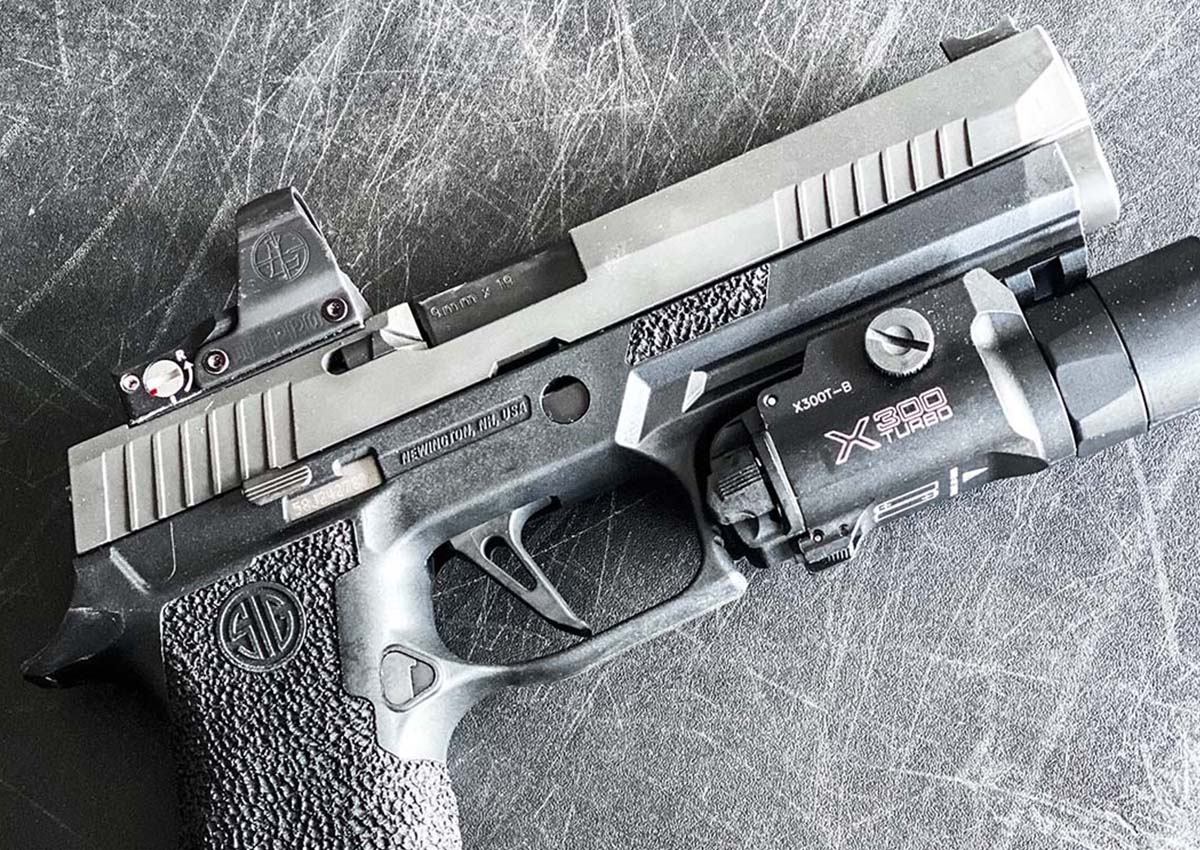Best Hunting Tripods of 2025, Tested and Reviewed
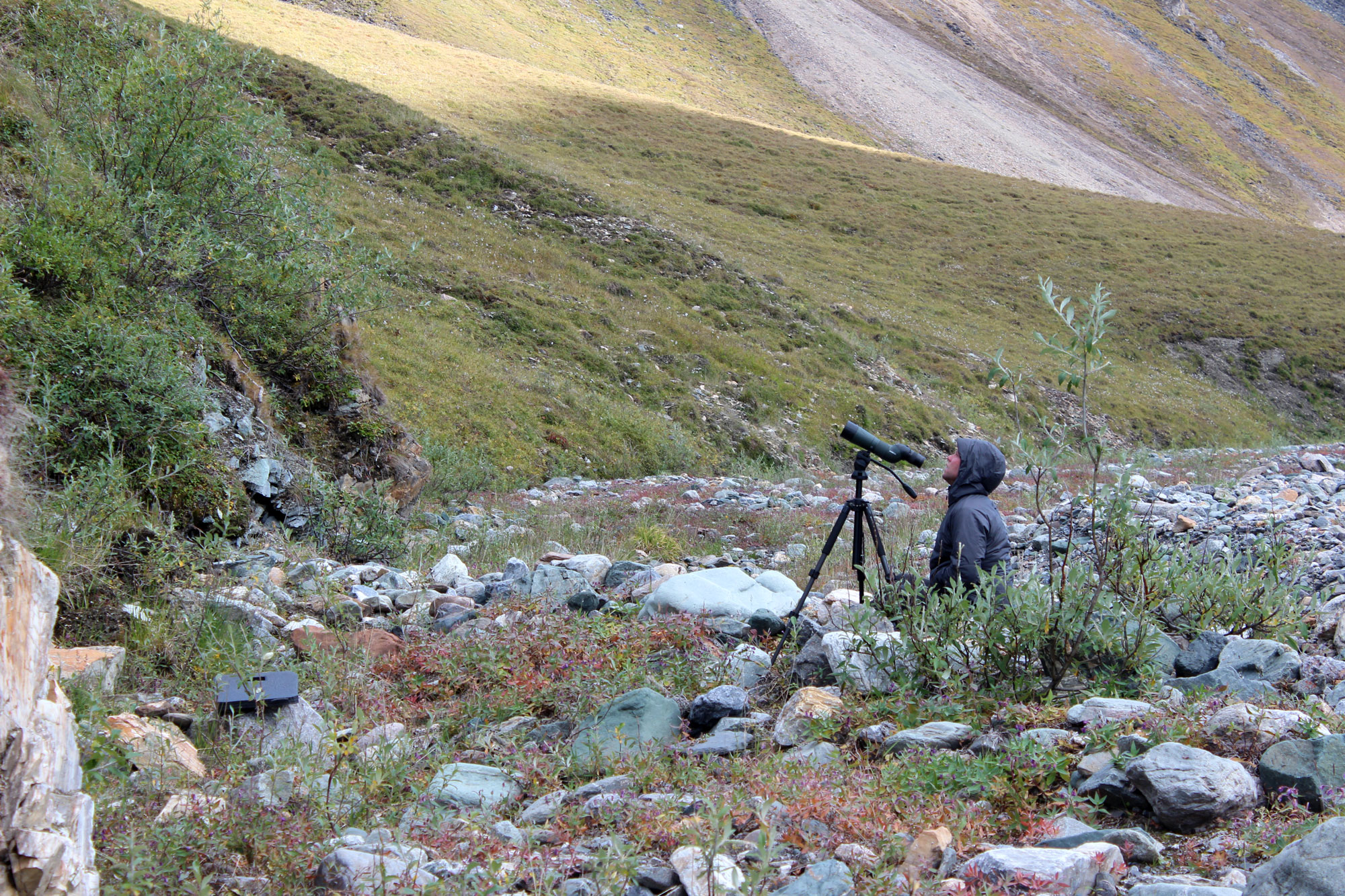
We may earn revenue from the products available on this page and participate in affiliate programs. Learn More ›
Stabilizing a spotting scope makes every hunter more effective, but it’s especially useful in the backcountry, where good optics anchored to a hunting tripod can save you many miles of hiking and many torturous feet of steep terrain. Tripods can also elevate your shooting skills. By providing a tall, extremely stable, and more adaptable alternative to a rifle-mounted bipod, a tripod allows shooters to stand, pan, and pivot in order to engage targets at a variety of elevations, distances, and directions.
All these tasks are possible with traditional aluminum tripods, but they are relatively heavy, clunky, and often loud. Carbon fiber has been a lighter, more compact, and vibration-dampening alternative for years, but it’s also very expensive. That’s changing, as manufacturing techniques are lowering the cost of carbon and making the material stronger, lighter, and stiffer. Carbon tripods remain an investment, which is why it’s important to know what to expect from the best hunting tripods before buying them.
How I Tested the Best Hunting Tripods
I considered a variety of carbon fiber tripods for this buyer’s guide. Some are intended as rifle supports, others as extremely lightweight options for backpacking hunters who want to stabilize a compact spotting scope or powerful binocular. And a third group splits the middle, bringing enough heft to support full-sized spotting scopes and most rifles while weighing under four pounds, about the limit for packability.
I put each model in this roundup through the same basic regimen. First, I weighed and measured them to confirm (or sometimes correct) manufacturers’ claims. Then I extended them to their maximum length and mounted a series of optics and rifle accessories, depending on their utility. For the smaller tripods, I used a 50mm spotting scope and bracket to support a 15×56 binocular. For the larger tripods, I mounted a big 85mm scope. And for the shooting supports, I mounted and then shot an 11-pound chassis rifle, determining how nimble, smooth, and strong each tripod felt while I was behind the rifle.
Lastly, I measured leg diameter. That’s an important consideration as the beefier the legs, the more stable the tripod, but also the more it weighs. And I assessed the price/value of each of these and examined their warranties. That last consideration is important in order to protect your significant investment.
Best Hunting Tripods: Reviews & Recommendations
Best Overall: Really Right Stuff TFCT MK 2
See It
Pros
- Sturdy as hell
- Easy to set up and maneuver
- Head accommodates ARCA and Picatinny rails
Cons
- Expensive
- Heavy for backcountry hunting
Key Features
- Weight: 5 pounds, 2 ounces
- Load Capacity: 70 pounds
- Leg Diameter: 37mm
- Anvil 30 ARC Ball Head
- Price: $1,550
This tripod has been a mainstay of my hunting and shooting kit for years. Whether I’m going to the range, shooting in a competition, or hunting, the RRS TFCT Field Grade Tripod is by my side.
This was about the first tripod built specifically for dynamic precision shooting. It is strong enough to handle the beefiest 25-pound PRS guns while making it easy to shift the point of aim thanks to the smartly designed Anvil 30 ARC ball head.
The throw-lever on the ball head is quite sensitive, letting the user adjust the tension so the rifle can pan smoothly from one target to the next (or follow a moving target) and then hold the rifle in place when you let go. It will also lock the rifle immovably in place by closing the lever.
The head lets you get items equipped with ARCA or Picatinny rails in and out easily. The head is also tunable to accommodate rails that might not be quite in spec, which often happens.
The legs have four sections that let them expand from 23 inches to 74.5 inches. At full height the tripod works as an excellent rear support. Each leg can be positioned at three angles, so it is easy to create a shooting position under on any kind of terrain. I’ve used mine in some crazy rocky outcroppings with a steep downhill slope – and even under those conditions the RRS came through.
They are expensive, yes, but no other heavy-duty tripod can equal their easy of operation, versatility, and rock-solid stability and construction. — John B. Snow

See It
Pros
- Extremely light
- Quick to deploy
- Works well with angled and straight spotters
- Bush-adjust three-position legs
Cons
- Doesn’t come with pan head
- Can be shaky in high winds
Key Features
- Weight: 1 pound, 4 ounces
- Load Capacity: 14 pounds
- Maximum Leg Diameter: .875 inches
- push-button leg position adjustments
- Elevating center column
- Price: $275
The Aziak Backcountry Lite is one of the best tripods for the ultralight backcountry hunter who still want’s a stable, functional tripod. It weighs 20 ounces and has three-section adjustable carbon-fiber legs. Fully extended, this tripod can have your binos or spotter approximately 48 inches off the ground. The leg position can be adjusted as well, via a push-button latch at the top of each leg. There are three possible positions which can get the tripod very low to the ground or accommodate uneven terrain.
The downside is that this tripod doesn’t come with a pan head, but match it to the head of your choice for a great backcountry option. I’ve been carrying the backcountry lite Dall sheep hunting in Alaska for the past couple years, and it’s provided great versatility and stability while being wonderfully packable. Stowed, it’s only bout two inches in diameter, but the turn-lock knobs make the legs quick to deploy and adjust. It can even be used as primary or rear support for shooting. -Tyler Freel
Best Compact Tripod: Spartan Precision Hoplite

See It
Pros
- Light
- Very versatile
- Highly adjustable
- Great for shooting support or spotting scope
Cons
- Not tall enough for binos
- Not great for straight eyepiece spotters
Key Features
- Weight: 1 pound, 5 ounces
- Load Capacity: 20+ pounds
- Maximum Leg Diameter: 16mm
- push-button and twist-lock leg position adjustments
- Compatible with longer leg options
- Price: $600
Spartan Precision equipment is known for creative ideas and striving to produce the highest quality gear possible. The Hoplite mini tripod is an ultralight modular tripod that, for the right hunter, makes the ultimate backcountry shooting and glassing platform. Folded up, it’s 12 inches long and 3 inches in diameter, but can extend to 17 inches tall. It uses interchangeable legs that have one pull-out section and another that’s twist lock. The hybrid aluminum and carbon-fiber design allows for quick adjustments and also a very short low-end adjustment setting that’s 7.5 inches tall for shooting a rifle prone.
For a hunter who uses an angled spotter and wants to use their tripod as a primary shooting support, this is an appealing option. Longer legs can be purchased, and the Hoplite is rated for heavy magnum rifles. It comes standard with Spartan’s proprietary magnetic stud attachment system, but can be adapted to use with a standard pan head. -Tyler Freel

See It
Pros
- Accessible price
- Wide variety of attachments
- Blue accents provide distinctive look
- Extends to 70 inches
Cons
- Carbon fiber legs are rough
- Head loosens over time
- Could use a sexier name
Key Features
- Weight: four pounds
- Load Capacity: 30 pounds
- Maximum Leg Diameter: 40mm
- Ball and fluid panning heads
- Price: $400
With a dizzying number of accessories and amenities, this workaday carbon tripod can morph from supporting a spotting scope to accommodating a smartphone to accepting almost any aftermarket shooting saddle. While it doesn’t do any single task particularly well, it has more versatility than any tripod on the market. And priced at about $300, it’s a good value considering its peers cost about $100 more.
A full-sized and full-service carbon fiber tripod for under $400, the Meopta unit is more than just a 3-section, twist-lock enabled tripod. It’s a whole kit, shipping with a ball and fluid panning head, two different plates, a smartphone bracket, and screw-in spike feet for those times you need to anchor the legs into gravel or sod. Weighing just four pounds, it can handle full-sized spotters and most rifles, it extends to 70 inches, and its 3-position legs can splay out to stabilize loads in high winds.
Best Value for Precision Shooting: Two Vets Recon V2 LS i

See It
Pros
- Extremely Stury
- Easy to adjust
- Quality Components
- Good Value
Key Features
Two Vets is a scrappy company that makes great products at attractive prices. For those that cannot afford the stratospheric price tags that the ultra-premium brands carry, the offerings from Two Vets are a welcomed relief.
The Recon V2 LS i is one of my favorites from Two Vets. It does well as an all-around tripod — it’s a fine choice for glassing or taking on hunts that don’t involve insane amounts of elevation — but it really comes into its own as a rifle support in shooting competitions.
The “i” in the tripod’s name stands for inverted, which is how the three sections of legs are oriented. This lets the user extend the legs through their full range without needing to reach far down the legs to do so. With this design, the quarter-turn locking rings are always within easy reach, which can save critical seconds during a match stage. It is far more efficient and makes the user less prone to fumbling.
The locking rings are smooth and easy to twist. The legs glide smoothly through their range of motion, extending from 30 inches fully collapsed to 70.5 inches at max height. If there’s one downside to the tripod is that it is still quite large when stowed, making it cumbersome for some hunting applications.
The legs themselves cost just over $600, and then you have several ball heads to choose from. I went with a fairly basic 55mm head with an ARCA plate head that uses a throw lever for $300. So, for less than a grand you have a tripod that is almost as good as others costing hundreds more. — John B. Snow
Best for Deer Hunting: BOG DeathGrip Carbon
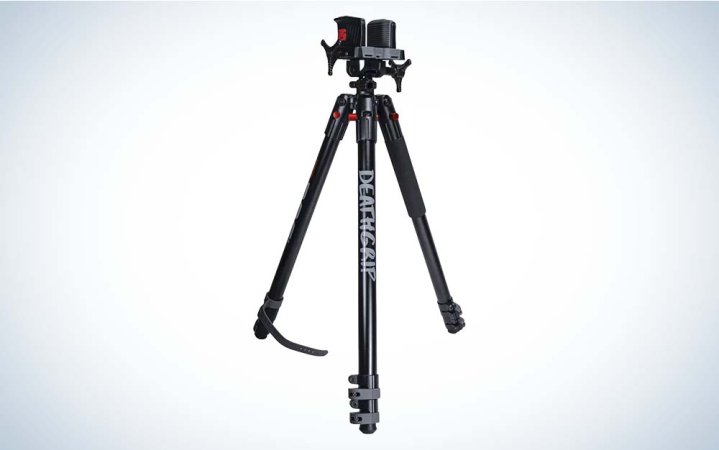
See It
Pros
- Accessible price
- DeathGrip saddle is stable but won’t mar gun
- Legs lock in three different positions (20, 45, and 85 degrees)
- Bubble helps to level head
- Tension control is easy to use
Cons
- Push-button leg locks are easy to bump
- Hard to swap heads
Key Features
- Weight: 7.5 pounds
- Load Capacity: 30 pounds
- Maximum Leg Diameter: 40mm
- DeathGrip shooting saddle
- Price: $200
Optimized for hunters who shoot from tree stand platforms or ground blinds, this tripod and associated shooting saddle is infinitely adjustable and can accommodate just about any gun or crossbow. Because it will hold a gun at the ready, the DeathGrip is a smart choice to use with beginning hunters, whose arms frequently tire from holding a gun, and whose nerves sometime pull their gun off target. With this simple support, a gun or crossbow can be held in position with minimum fuss or noise. Also available in an aluminum-leg model, the DeathGrip Carbon is light enough to pack and the carbon legs minimize flex and vibration, providing a very stable platform.

See It
Pros
- Huge extension range
- Lightweight
- Configured for smartphone use
- Accessibly priced
Cons
- Can’t stabilize full-sized spotting scopes
- Thin lower leg sections are fragile
Key Features
- Weight: 2.3 pounds
- Load Capacity: 8.8 pounds
- Maximum Leg Diameter: 22mm
- Bluetooth-enabled remote
- Price: $260
A super-compact travel tripod, the Vanguard VEO3 packs a ton of versatility into its small stature. Its 5-section legs and 2-section carbon center post adjust with twist-lock controls, extending from 13 to 53 inches. One of the legs converts to a monopod or selfie stick. The ball-head is nimble and fairly tight, and smartphone users will like the Bluetooth-enabled remote that allows for hands-free camera use.
While this can’t be considered a full-sized tripod, largely because its load capacity is limited to under 10 pounds, this super-convertible unit does just about everything short of supporting a big optic. It extends from a very compact 13 inches up to 53. Its T-50 ball head is fully compatible with Arca-Swiss components and one leg can be removed and converted to a monopod or selfie stick. It’s a strong choice for sticking in a backpack or even a duffle bag for travel, and at just over $200, it’s priced attractively for a fully carbon tripod.
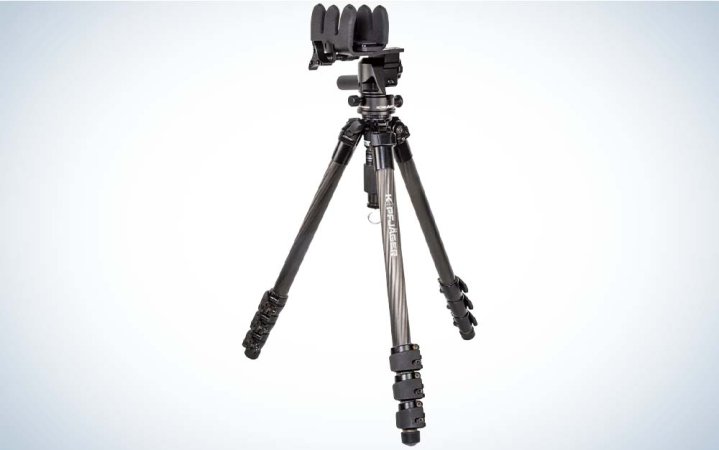
See It
Pros
- Snap-lock legs easy to deploy
- Base tripod accepts most standard heads
- Grip provides 360-degree panning and 109 degrees of tilt
Cons
- Snap locks can get fouled with mud and grit
- Carbon legs are slick when wet
Key Features
- Weight: 3.5 pounds
- Load Capacity: 20 pounds
- Maximum Leg Diameter: 40mm
- Extends to 65 inches, packs to 19 inches
- Price: $400
A favorite of Texas hog hunters, this is a hard-wearing, extremely versatile platform for rifles of all types deployed in all kinds of field conditions. Combined with the Reaper head, the tripod is stable enough to enable the variable shooting conditions encountered in high-volume hog hunts.
A workhorse of a tripod that you’ll find in a lot of hog-hunter’s pickups, the Kopfjager is also available in an aluminum model (K700). I like the carbon for its light weight but also for its vibration-dampening talents, an important consideration when you’re making long shots through thermal optics at nighttime hogs. The Reaper grip, which you can buy separately if you want, accommodates a wide range of the best rifles, from chassis guns to ARs. And when you don’t want to support a rifle, the tripod is compatible with most ball-mount heads with 3/8-16-inch threads.

See It
Pros
- Extremely high weight-to-load ratio
- Twist-lock legs are stout and smooth
- Precision-machined hardware
- Safety-lock head release is strong and easy to use
Cons
- At over $1,000, it’s pricey
- Users must buy aftermarket accessories
Key Features
- Weight: 7.3 pounds
- Load Capacity: 55 pounds
- Maximum Leg Diameter: 40mm
- Extremely smooth ball head
- Price: $1,300
The pinnacle of Leupold’s carbon fiber tripod line, this is a rock-solid shooting platform and almost infinitely versatile with Leupold’s aftermarket accessories, which include shooting saddle, binocular field clamp, and binocular tripod adapter. The 10-layer carbon fiber legs are elegant and strong. This investment-grade tripod handles just about any shooting or glassing task asked of it. The CF-455 fits nicely in Leupold’s Mark 5 product line, offering best-in-class durability and performance. It’s useful to know it also sits atop Leupold’s relatively new carbon tripod line, offering more of everything—leg diameter, weight capacity, extension, and versatility—than the Alpine and Pro Guide tripods. Plus, it’s lovely to look at and doesn’t scream tactical as many of its peers on the firing line do.

See It
Pros
- Classy and strong grade of carbon fiber
- Twist-lock leg hardware deploys quickly
- Head pairs with wide range of optics adapters
- Extremely light and packable
Cons
- Tiny mounting plate is easy to lose
- Removable center post is also easy to lose
- Too small for full-size spotters
Key Features
- Weight: two pounds
- Load Capacity: 13 pounds
- Maximum Leg Diameter: 22mm
- Two-way panning head with Arca-Swiss compatibility
- Price: $370
Weighing just two pounds and packing down to 18 inches, this tripod fits in just about any pack or backcountry hunt. It’s surprisingly strong and durable for its fine bones. One of a class of ultralight tripods (Vortex’s Summit Carbon II and Vanguard’s VEO3 are the others in this roundup), the Alpine’s name says it all. This is an optics-ready platform for binoculars or mid-sized and compact spotting scopes that’s at its best when ounces count. It’s a handy shooting platform when paired with aftermarket accessories such as Spartan’s Davros head and rifle socket. The carbon legs do a nice job of dampening vibrations, and the head pans and tilts smoothly.
Vortex High Country II
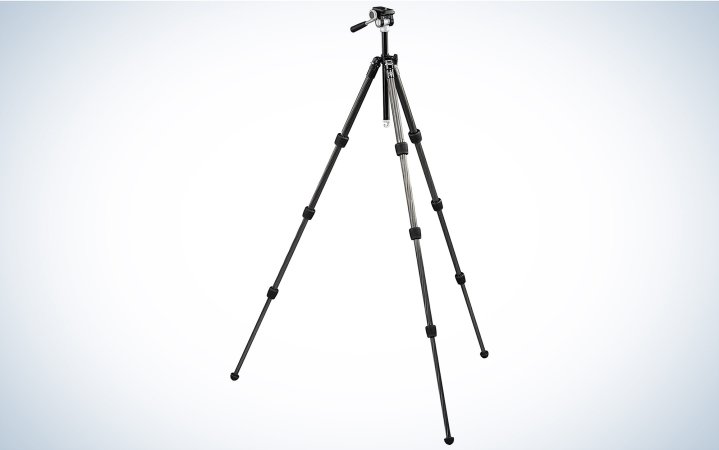
See It
Pros
- Smooth pan head
- Great for spotting scopes, binoculars, light rifles, and photography
- Folds up small
Key Features
- Weight: 4.0 pounds
- Min Height: 11.3 inches
- Max Load: 22 pounds
- Max Height: 62.5 inches
- Price: $370
The tripod world is currently dominated by light and expensive carbon models. While there’s no doubt carbon tripods are superior, there’s still a place for more affordable aluminum versions. For example the High Country II Kit costs $200 and you can get the similarly sized Vortex Summit II carbon tripod for $400. So we’re talking about half the price for an aluminum tripod.
What you get is a tripod that can deploy from about a foot off the ground to 5 feet off the ground. With that range it can hold a spotter while you shoot prone up to glassing while standing. The High Country II is fit for packing in on a hunt, as long as you are OK with it weighing a little (about 1.5 pounds more than the carbon version). This tripod isn’t the best option for use as a shooting rest. At the 2023 Outdoor Life gun test we shot off the High Country II and a much stiffer carbon tripod. We saw more scope movement on the High Country II, and even just pressing down on the tripod you can see the legs flex. If you are looking for a tripod to make precise shots at long ranges, there are much better options for that purpose.
However, if you need a tripod that won’t break the bank and pans smoothly while glassing, then the High Country II is definitely worth consideration.
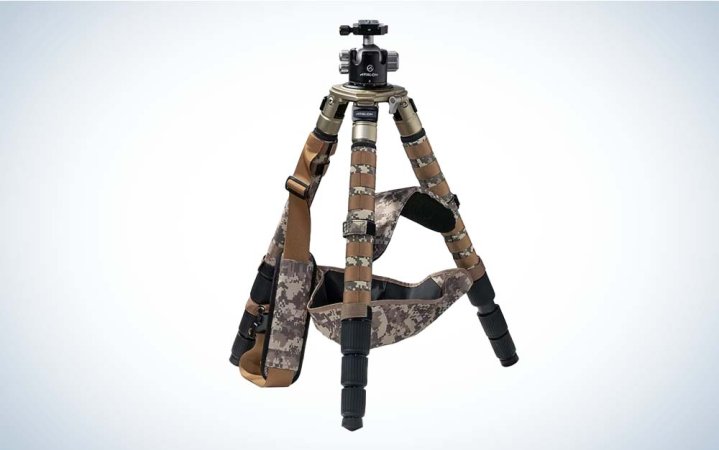
See It
Pros
- Arca compatibility for direct-to-rifle attachment
- Includes hammock to add stabilizing weight
- Capable of supporting 88 pounds
- Molle leg protectors look tacti-cool
Cons
- Expensive
- Big (29 inches folded) and heavy (8.4 pounds)
Key Features
- Weight: 8.4 pounds
- Load Capacity: 88 pounds
- Maximum Leg Diameter: 40mm
- Ships with two heads, tripod hammock
- Price: $699
This is a serious (and seriously expensive) piece of shooting kit, but it’s packed with value: two different heads to accommodate either rifles or optics, the beefiest carbon legs in our field, and high-quality components.
The Midas, which is the largest and strongest of Athlon’s line of carbon tripods (or any other in this roundup), ships as a complete kit, with both a ball and leveling head, shoulder strap, hammock for adding rocks and other weight to the legs, and a cup mount with tension control for shooters. Its 10-layer carbon legs are among the smoothest and strongest in the field, and the twist-lock controls and aluminum hardware are smooth and strong. If you’re a competition shooter looking to get off the ground and get right into the long-range game, this is a great choice because you don’t have to ala mode the components; they’re all included.
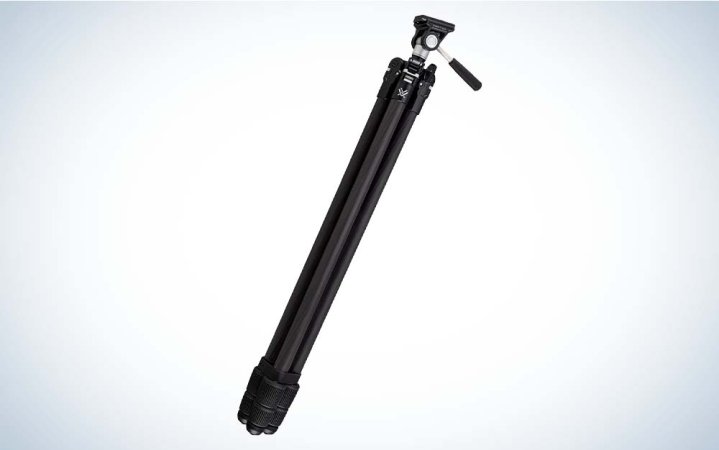
See It
Pros
- Extends to 73.8 inches
- Twist-lock leg controls deploy quickly
- Tension control on panning head is easy to use
- Light enough for a backcountry option
Cons
- Unstable at highest extension
- Not for use with heavy rifles
Key Features
- Weight: three pounds
- Load Capacity: 22 pounds
- Maximum Leg Diameter: 26mm
- Smooth and strong 2-way pan head
- Price: $500
A highly versatile size and weight, the Ridgeview occupies the middle ground of Vortex’s line of carbon tripods but leans more toward backcountry hunting than front-country shooting support. The Ridgeview is strong enough to support a full-size spotter, unusual in this class.
The most versatile tripod in this field, the mid-sized Ridgeview Carbon is stout enough to support most optics, and it’s extremely packable. It would make a very good travel or birdwatching unit, quick to deploy, useful for cameras or a wide variety of optics. The mid-weight carbon legs do a nice job of dampening most vibrations, but users will want to invest in a hammock or center-post weight to add even more dampening to the unit in windy conditions. And the Arca-Swiss-compatible plate mates up with most mounting systems.
How to Choose the Best Hunting Tripod
Buying a carbon-fiber tripod isn’t a frivolous task. The most expensive cost over $1,000, and even entry-level units will set you back nearly $300. Your first task is to think through how you’ll use it. If you’re a backcountry hunter looking for a lightweight and packable tripod that will stabilize a mid-sized spotting scope or binoculars, look for units in the 2- to 3-pound range that pack to about 18 inches. If you want a tripod as a shooting platform, you’ll want a model with a bowl mount that will accept a shooting saddle or some other rifle holder.
No matter the purpose, look for tripods with high-grade hardware. That includes tight leg locks—whether twist or flip locks—and head/plate furniture. Test the heads for fluid panning and angle control. And lastly, consider compatibility with a wide range of optics and accessories. The best have either Arca-Swiss heads or those with 1/4-20 thread pitch.
Read Next: The Best Shooting Bags of 2023
FAQs
Look for a tripod that is light enough for you to pack around, but stable enough for your glassing or shooting. You want one that will accommodate the glass you personally use, and work as rifle support too.
Yes and no. Dedicated rifle tripods are usually very hefty and stable, but that’s also great for spotting scopes. Generally, you can use many glassing tripods as shooting support, but you’ll sacrifice some stability.
Most spotting scope tripods will accept a variety of heads and attachments, and can also be used for shooting or photography.
Final Thoughts
While there are plenty of aluminum tripods on the market, the trend is decidedly toward carbon fiber. It makes sense, as it’s easier to produce all the time and manufacturers have figured out that it makes a very capable material for the best hunting tripods. With good care and making sure not to overload them, carbon fiber provides a strong, versatile, and lightweight platform for a wide variety of glassing and shooting tasks.
Read the full article here



